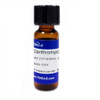Clarithromycin related compound H, EvoPure (3″-N-demethyl-3′-N-formyl-6-Omethylerythromycin A) is a highly purified impurity found in Clarithromycin that can be used as a reference standard.
We also offer:
- Clarithromycin, USP (C128)
- Clarithromycin related compound C, EvoPure (C128)
- Clarithromycin related compound D, EvoPure (C140)
- Clarithromycin related compound I, EvoPure (C131)
- Clarithromycin related compound J, EvoPure (C132)
- Clarithromycin related compound K, EvoPure (C133)
- Clarithromycin related compound L, EvoPure (C134)
- Clarithromycin related compound M, EvoPure (C133)
- Clarithromycin related compound Z, EvoPure (E022)
| Application | Clarithromycin related compound H, EvoPure® can be used as a reference standard. Reference standards are well characterized, highly pure compounds that can be used to help identify and/or quantify impurities in pharmaceutical compounds and antimicrobials. |
| Mechanism of Action |
Macrolide antibiotics inhibit bacterial growth by targeting the 50S ribosomal subunit preventing peptide bond formation and translocation during protein synthesis. Resistance to Clarithromycin is commonly attributed to mutations in 50S rRNA preventing Clarithromycin binding allowing the cell to synthesize error-free proteins. Anti-cancer mechanisms include reduction of cytokines, inhibition of autophagy, and anti-angiogenesis. The compound can act on signal transduction pathways, transcription factors, drug pharmacokinetics, growth signals, and metastasis. These features can be exploited to make tumor cells more prone to apoptosis and reduce escape mechanisms. The mechanism used depend on the type of cancer. |
| Spectrum | Clarithromycin is a broad-spectrum antibiotic with bacteriostatic action wide range of Gram- positive and Gram-negative bacteria including anaerobes. It is also effective for Mycoplasma and Mycobacteria. |
| Microbiology Applications | Clarithromycin is commonly used in clinical in vitro microbiological antimicrobial susceptibility tests (panels, discs, and MIC strips) against Gram-positive and Gram-negative bacteria. Medical microbiologists use AST results to recommend antibiotic treatment options for infected patients. Representative MIC values include:
Clarithromycin (TOKU-E) used in methacrylate-based copolymer films that released the compound (along with doxycycline and rifampicin) for up to 21 days were found to prevent biofilm formation when in an in vitro bioreactor model (Rose et al, 2015). |
| Eukaryotic Cell Culture Applications | An in vitro study on the inhibitory effect of Clarithromycin on transporter-expressing HEK-293 cell lines or membrane vesicles with 13 drug transporters (OATP1B1, OATP1B3, OAT1, OAT3, OCT1, OCT2, MATE1, MATE2-K, P-gp, BCRP, MRP2, MRP3, and BSEP) were systematically assessed and results were that inhibition profiles were unique to the transporter (Vermeer et al, 2016). Macrolide antibiotics exert anti-inflammatory effects through inhibition of the production of proinflammatory cytokines. Nuclear factor kb (NF-kb) is an important transcription factor for genes that encode proinflammatory cytokines. In vitro studies with human monocytic leukemia cell line U-937, human T-cell leukemia (Jurkat), a pulmonary epithelial cell line A549, and peripheral blood mononuclear cells were conducted. Clarithromycin was found to suppress the production of proinflammatory cytokines via inhibition of NF-kb (Ichiyama T et al, 2001). Clarithromycin can have immunomodulatory activity on human lymphocyte function. The compound suppressed the synthesis of IL-1a, IL-1b, TNF-a, and GM-CSF in a concentration-dependent manner. This suggests Clarithromycin may modify the acute-phase inflammatory response by disturbing the cytokine cascade (Morikawa K et al, 1996). |
| Cancer Applications | Clarithromycin is involved in autophagy-lysosome pathway. It can inhibit autophagy in myeloma and myeloid leukaemia cells. It inhibits lysosomal function after fusion of the autophagosomes with the lysosomes. Thus, it could be a potential adjuvant where autophagy is used by the tumor as an escape mechanism. (Nakamura et al, 2010)
The combined treatment of clarithromycin with the proteasome inhibitor bortezomib enhances cytotoxicity in the breast cancer cell lines MDA-MB-231 and MDA-MB-468. A wild-type murine embryonic fibroblast (MEF) cell line also exhibited enhanced cytotoxicity (Komatsu et al, 2012). Direct antineplastic effects of CAM may depend on the tumor type. Researchers found a direct anti-tumor activity of CAM on lymphoma cells (Ochi et al, 2006) and it directly induced apoptosis in a murine B cell lymphoma cell line (Ohara et al, 2004). |
| References | Goldman RC, Zakula D, Flamm R, Beyer J, Capobianco J (1994) Tight binding of Clarithromycin, its 14-(R)-hydroxy metabolite, and erythromycin to Helicobacter pylori ribosomes. Antimicrob. Agents Chemother. 38(7):1496-500. PMID 7979278 Komatsu S et al (2012) Clarithromycin enhances bortezomib-induced cytotoxicity via endoplasmic reticulum stress-mediated CHOP (GADD153) induction and autophagy in breast cancer cells. Int. J. Oncol. 40(4):1029-1039 PMID 22200786 Tenson T, Lovmar M and Ehrenberg M (2003) The mechanism of action of macrolides, lincosamides and streptogramin B reveals the nascent peptide exit path in the ribosome. J. Mol. Biol. 330(5):1005-1014 PMID 12860123 Morikawa K, Watabe H, Araake M and Morikawa S (1996) Modulatory effect of antibiotics on cytokine production by human monocytes in vitro. Antimicrob. Agents. Chemother. 40(6):1366-1370 PMD 8726002 Nakamura M et al (2010) Clarithromycin attenuates autophagy in myeloma cells Int J Oncol 37:815–320 PMID 20811702 Niemi M, Neuvonen PJ, and Kivisto KT (2001) The cytochrome P4503A4 inhibitor Clarithromycin increases the plasma concentrations and effects of repaglinide. 70(1):58-65 PMID 11452245 Ochi M et al (2006) Regression of primary low-grade mucosa-associated lymphoid tissue lymphoma of duodenum after long-term treatment with Clarithromycin. Scand J Gastroenterol 41:365–369 DOI: PMID: 16497629 Ohara T et al (2004) Antibiotics directly induce apoptosis in B cell lymphoma cells derived from BALB/c mice Anticancer Res 24(6) pp 3723–30 Rose, WE et al (2015) Prevention of biofilm formation by methacrylate-based copolymer films loaded with rifampin, Clarithromycin, doxycycline alone or in combination. Pharm. Res. 32(1): 61-73 PMID 24934663 Ichiyama T et al (2001) Clarithromycin inhibits NF-κB activation in human peripheral blood mononuclear cells and pulmonary epithelial cells. Antimicrob. Agents. Chemother. 45 (1): 44-47 PMID 11120942 Van Nuffel AMT et al 2015 Repurposing drugs in oncology (ReDO)- Clarithromycin as an anti-cancer agent. Ecancer 9:513 Vermeer LMM, Isringhausen CD, Ogilvie BW and Buckley DB (2016) Evaluation of ketoconazole and its alternative clinical CYP3A4/5 inhibitors as inhibitors of drug transporters: The in vitro effects of ketoconazole, ritonavir, Clarithromycin, and itraconazole on 13 clinically-relevant drug transporters. Drug Metab. Disp. 44 (3) 453-459 PMID 26668209 |







